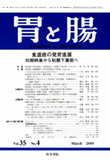Japanese
English
- 有料閲覧
- Abstract 文献概要
- 1ページ目 Look Inside
- サイト内被引用 Cited by
要旨 食道癌の組織構築の解析を行い発育進展様式を推察した.48症例(56病変)の深達度smまでの食道扁平上皮癌を対象とした.組織構築は増殖様式を基底層型と全層型に,癌の粘膜内成分の厚さを非腫瘍粘膜と比較して薄型,平坦型,肥厚型に分類し,癌の大きさや深達度などの臨床病理学的諸因子との相関を解析した.その結果,食道癌は発生のごく早期では平坦粘膜の基底層から始まり(IIb),次に基底層が希薄化し(IIc),次に全層を巻き込み増殖し癌成分の肥厚性発育をとり(IIcまたはIIa),大半は大きくなる過程で全層性増殖かつ肥厚性発育部位より浸潤を始める経路が主であると考えられた.それらが潰瘍化するとIII型あるいは2型へ進行し,上皮下浸潤により下から盛り上げるとI型となることが推測された.全層性増殖かつ肥厚性発育成分が浸潤性を獲得しないで拡がると表層拡大型へ進展することも示唆された.また,全層増殖する前に浸潤し粘膜下腫瘍様の発育をするものも低頻度ながら存在すると考えられるが,それらは基底細胞癌などの特殊な組織型のものであると考えられた.
We analyzed the histologic architectures of superficial esophageal carcinomas, and considered their growth patterns. Forty-eight cases with 56 lesions were selected for this study, all of which were confined to the mucosa and submucosal layers of the esophageal walls. The proliferative patterns within the mucosa were classified into two ; basal- and whole thicknesstypes. The thickness of the non-invasive mucosa components were classified into three ; thin-, flat-, and thick-types. The correlation between the histologic architectures and clinicopathologic factors was investigated. The following hypothesis could be considered. In the earliest stage, the carcinomas arise at the basal layer of the mucosa (0-IIb type) . Next, they involve the whole thickness of the mucosa, thinning the mucosal component (0-IIc type) or thickening the mucosal component (0-IIa type) . Thirdly, most of them invade the submucosa at the area of whole thickness involvement and thickening components. When they are ulcerated, they develop into 0-III or 2 type. When they mainly grow beneath the mucosa, they form a polypoid mass (0-I type) .

Copyright © 2000, Igaku-Shoin Ltd. All rights reserved.


